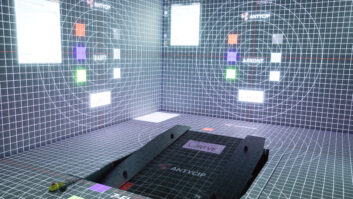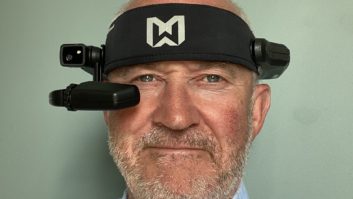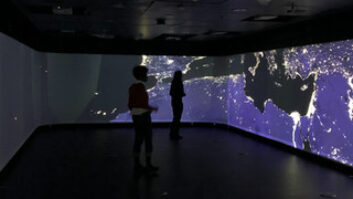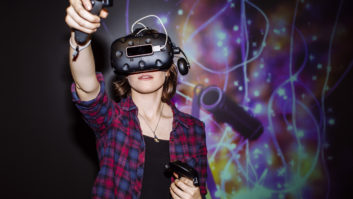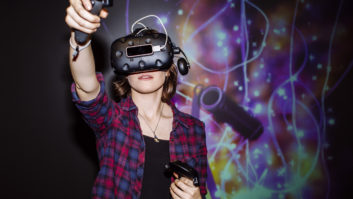 The entertainment industry is experiencing a convergence of technology – real-time engines for games are now being utilised to generate photo-real graphics for film and television. Video games themselves have also seen vast new worlds open up within them, hosting live virtual performances from global bands and artists promoting new material. As audiovisual technology begins to align itself to cater for the growing demand for immersive, mixed reality entertainment, we are entering the age of the metaverse.
The entertainment industry is experiencing a convergence of technology – real-time engines for games are now being utilised to generate photo-real graphics for film and television. Video games themselves have also seen vast new worlds open up within them, hosting live virtual performances from global bands and artists promoting new material. As audiovisual technology begins to align itself to cater for the growing demand for immersive, mixed reality entertainment, we are entering the age of the metaverse.
Extended Reality (XR) is a term that encompasses VR (virtual reality), AR (augmented reality), and MR (mixed reality) among others, and is generally applied to projects that use both hardware and software to generate media experiences that enhance the perception of viewers in ways previously unattainable via traditional formats. While many of these terms have become commonplace today, the industry, in its advanced form at least, is still relatively young.
EXPANDED REALITIES
2013-14 marked the beginning of the mixed reality’s expansion into the mainstream. Back then, these different virtual technologies were initiated by hobbyists and enthusiasts online – I was working in traditional filmmaking at the time but could already see the unending potential this new technology offered.
The nature of the technology made it disruptive, this wasn’t just a gimmick or an adjustment to traditional viewing consumption like 3D cinema. For instance, if you take the film and television industry – which is over 100 years old – there’s an established hierarchy, from the top-end companies, such as Warner and Disney, descending all the way down to the indie studios. The key players have far more creative and economic control. But
with the introduction of entirely new technologies like VR, everyone entered the same playing field, with indie developers solving the exact same challenges facing the world’s biggest companies.
Developers of all levels were asking the same questions: “How do I transport someone into a realistic, and believable virtual experience. How do they travel? Interact? Meet other people?” All of the previously unapproachable leading companies became your peers – you could go straight to Microsoft or a big VFX company with your idea. The industry was rife with opportunities, and in many key ways, still is.
CONVERGING LANES
The explosion of research into virtual tech has led to multiple avenues of fresh discovery. Whether it’s VR, AR, or virtual production with LED walls, virtual technologies are more widespread than they ever have been, and it’s down to a multitude of companies specialising and overcoming the challenges.
As 2020 began, the fundamental focus in the industry was to create an overarching experience that could combine everything. Individual solutions, such as using VR only, couldn’t overcome the original challenge to create a truly immersive experience. With the different technologies used together, this hurdle became surmountable.
Dedicated facilities and interconnected infrastructure needs to be built in an attempt to industrialise immersive media. This could allow studios to take an artisan approach into an industrial process, making bigger and better immersive experiences than before.
During any kind of economic downturn, there’s always a negative effect on the functions of most industries – and the media and entertainment sector is still in recovery mode from the effects of the ongoing pandemic. But like wildlife that springs out of the remains of a forest fire, unexpected responses and adaptations made during the pandemic are already growing into positive and robust outcomes.
The build-up to 2020 has positioned mixed reality and as an enabler, feeding the demand for enhanced communication experiences. Pre-pandemic, the advances were already happening, but the industry considered them nice-to-haves or optional. But with current restrictions in place, the creation of virtual experiences has accelerated. And due to the previous five years of technological developments, much of the tech was ready to go – rendering, video cards and 5G have improved rapidly, and the general awareness of virtual experiences amongst the general public has skyrocketed.
Additionally, the mass adoption of cloud infrastructure has made ‘wireless’ experiences far easier than ever before – we already have shared avatar platforms such as AltspaceVR and collaborative platforms like Spatial and The Wild. Russian Metaverse studio Sensorium Galaxy is even introducing virtual dating with both human users and even with AI characters.
FUTURE GAZING
The true fusion of all of these technologies in one environment is imminent – a metaverse that can generate the realistic, immersive experiences first imagined back in 2015. With ‘multi-reality’ experiences you can have holograms in space, solid mechanical objects, VR and more. Everything is fused into one. For the past year at Prox & Reverie, we’ve been building a studio lab with doorways and physical devices that enable people to jump into the metaverse and become part of truly unique experiences.
By harnessing the power of dedicated XR studio systems that plug everything into a giant immersive switchboard, studios can produce quick and cost-effective spatial media that’s more immersive than anything created before. 2021 is our first step into the growing Metaverse.
